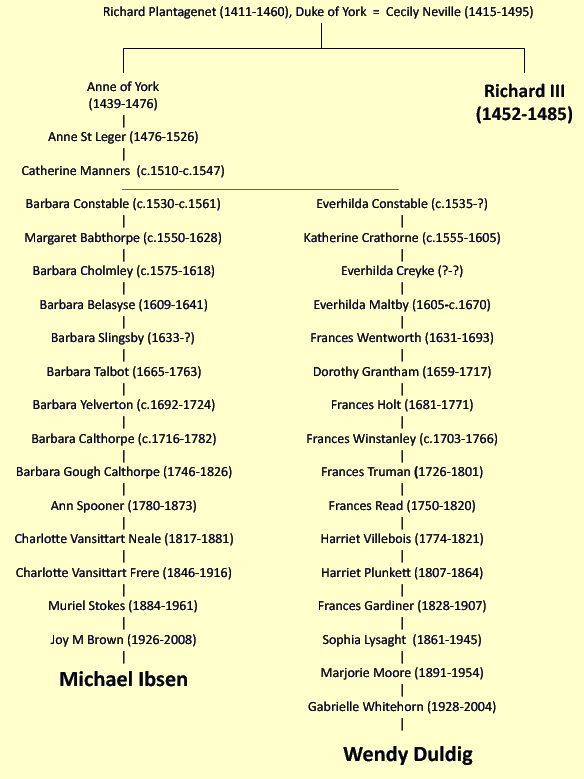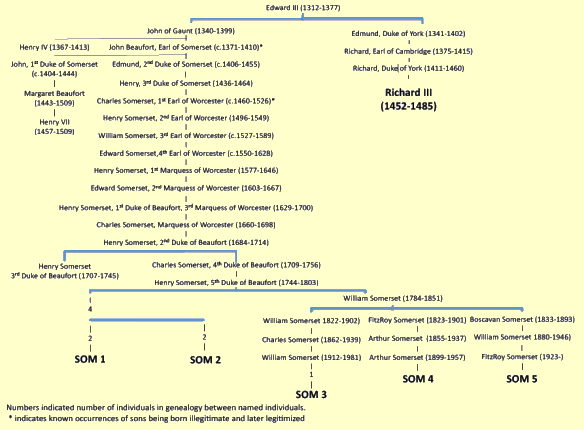You
are receiving this because your address is subscribed at: www.jaunay.com/newsletter.html |
|
 |
| No: 107 |
January 2015
|
|
News January Seminars There are no seminars planned for January. February Seminars 22: Nth Adelaide Heritage Walk: The Cathedral precinct 2:00–4:00pm WEA Centre Adelaide 24: Websites for family historians 6:00-9:00pm WEA Centre Adelaide 25: How to be a successful family historian (1st of 7 sessions), 8:00-9:30pm WEA Centre Adelaide All bookings must be made with the hosting organisation. See the seminar program for more details and bookings. NZ cemetery records Over 1.6 million cemetery records previously only available on microfiche or in printed form for the period 1800-2007 have been released by Ancestry. FamilySearch marriages FindMyPast have added over 31 million England and Wales marriage register entries which were transcribed by volunteers for FamilySearch. These records have been available at FamilySearch for some time, but now they are on a different platform it may be worth another check! There is no list showing which parishes are included, or the periods of coverage for individual parishes. To get round this problem type the name of the parish into the Place box on the search form to find out whether there are any records. Remember though that if you use the place feature and your ancestors married away from their parish you will not find them using this process! SA BDM indexes now online The South Australian BDM indexes created by GenealogySA are now available at FindMyPast. The site has the full version and not the summary version available at GenealogySA. England & Wales post-1858 probate A new service provides online access to the probate calendars for England and Wales and leads to an online ordering service. Previously in Australia the only easy access to probate calendars were via fiche at some major family history society libraries. |
In
this issue: |
|
Adelaide
Proformat Services
|
| DNA is not the answer to all questions
Sitting on a flight to Canberra in early December I took time to read the complimentary newspaper, The Australian, a pastime I rarely undertake these days with access to news being more convenient than a politically biased printed newspaper! I was interested to read an item from London about Richard III's DNA. Now I already knew that DNA extracted from a skeleton in an obscure Leicester carpark that was previously the site of an Augustinian Greyfriars Priory Church had indicated that the bones found were the remains of this King of England who must have had the worst public image of all his counterparts. Now the newspaper was reporting the tests had revealed a court sex scandal! The test to confirm the identity of the skeleton required tracing a direct all female descent line from Richard III's mother to the present. Not only no mean task but rather reliant on locating a relatively rare mitochondrial DNA (mtDNA) sequence! Rather unexpectedly both requirements came to pass and the bones were deemed to be those of the king. Drawing such a conclusion without other evidence is not good science. Given the number of generations since Richard’s mother, Cecily Neville, there must be millions of descendants. There is a good chance that almost everyone with English ancestry reading this article is related to Richard III. In this case the mtDNA just supported the other evidence at hand—archaeological, osteological, radiocarbon dating and genealogy! Still the skeleton could be another individual who is matrilineally related. However, taking all other clues and records into account, the scientists are 99% sure they have their man. Mitochondrial DNA is passed from the mother to all of her offspring, but only females pass it on. This is the DNA located in the mitochondria of the egg cell rather than in the nucleus. The researchers' published paper outlined the all female sequence from Richard III's sister to the present day. Richard’s sister, Anne of York, had two known living descendants. The results compared the full mitochondrial sequence, and it was determined that in one case, Richard and the participant were an exact match, and in the second case, there was only one mutation difference.  Typically, genealogists use mtDNA to explore ancient ancestry or more precisely to eliminate people who are not related through the maternal lines. If your mtDNA results do not exactly match someone else, you are most likely not closely related. Rarely do two people with one or more differences in their mtDNA have a common ancestor who lived recently enough that she might appear in the written record. This is because mtDNA mutates very slowly. The other DNA testing that could be undertaken is to follow the all male line and the Y chromosome. Here we face a significant problem. Male descent is often easier to trace because traditionally men are generally better documented than women, but while we can always be sure who someone’s mother was, the identity of their biological father may be less certain. This is what the newspaper article was all about. At least one male in the lineage to the present day was illegitimate! This was discovered simply because Richard III's line died out and so researchers had to go back in time to Edward III for whom they were able to obtain a sample of yDNA and then work through to the present day.  Interpreting yDNA test results presents challenges. The number of Y chromosome markers you get tested influences the reliability of these tests. Men can choose to test between 12 and 111 markers. The more markers tested, the greater the chance of finding genetic mutations (or differences) and, therefore, the smaller the chance of having an exact genetic match. In other words, a 67-marker test is more precise than a 12-marker test. Unlike mtDNA genetic mutation can occur at any time so even a father’s and son’s results might not match exactly. If two men have the same surname and the same yDNA test results, there’s a very good chance they’re related within a genealogically significant time period. One or two different marker values, depending on the number of markers tested, also could indicate a genetic link.  Two men with the same surname who display just one or two mismatches in a 36 marker test probably have a common ancestor who lived within the past 500 years. Two men with different surnames but with at least a 34 out of 36 match also suggests (but not prove) a common ancestor. There is a lesson in this exercise for the rest of us considering embarking on DNA testing to reveal ancestry. Apart from the cost factor we can see that a standard mtDNA test is not very helpful in a quest for ancestors. At best it will indicate from where on the globe your ancestors originated. Likewise a yDNA test will not help find ancestors in any direct way. Even if we were granted permission to exhume suspected ancestors, the chance of an ancient ancestor having recoverable yDNA is very remote. What a yDNA test will do is help find living male relatives but there are certain constraints. Apart from the fact illegitimacy may have occurred on one or more occasions, the more important factor is that the unknown relative will have to not only be in a program like you, that is, actively seeking their relatives but at this time they will have had to engage the same company you selected! This point means that if you embark on this quest then select a company that releases all the key data to you and upload it to a public DNA database. Again this in itself can be a problem, one such site, GeneTree, was purchased by Ancestry in 2013. Those who do not have a current subscription to Ancestry.com no longer had access to their GeneTree DNA results! Incidentally there is a lesson here for all those family historians who hand over their family tree data to online businesses too! On top of all this DNA tests have limits. If the archaeologists who discovered Richard III's skeleton did not already have a good idea who it might belong to, the mtDNA test probably would not have told them anything useful. It is the same with yDNA. The tests require supporting information. As we have now discovered, due to an illicit encounter the skeleton's yDNA is not a match with present day descendants either! The best supporting information are surnames and we know how readily some of these have changed over the years. In Ireland hereditary surnames were uncommon before the 10th century, in England before the 11th century and in Scotland before the 13th century. Many surnames have existed for far shorter periods.  Image from The Independent There are a number of factors that can cause a break in the surname sequence:
Where does this leave us? Over the past decade or so companies offering to test DNA for family history research started up. At first they were expensive and offered little more than a forensic test akin to the relatively simple tests to identify dead bodies against known material such as hair from a missing person's brush. Gradually they have become more sophisticated and relatively cheaper but are they worthwhile? You need to put the tests in perspective – yDNA follows your immediate male-to-male line only while mtDNA follows your female to female line. That means when you have gone back just seven generations where you in theory can have as many as 128 direct ancestors, the yDNA and mtDNA is following just two of these individuals – the other 126 are ignored! Newer genetic admixture tests examine DNA from genes inherited from all of a person's grandparents, great-grandparents, and so on – autosomal DNA [atDNA] – that is the DNA inherited on the autosomes which is the name for the 22 non-sex chromosomes. Scientists studying this field focus on sites in the DNA chain that vary between people by one chemical letter. These are called single nucleotide polymorphisms or SNPs (pronounced snips). Only some SNPs are important. They may contribute to traits like skin colour or resistance to regional diseases like malaria. Others vary among populations just because of chance. What they will not tell you is your origins. From a practical point of view, that is the biggest problem with all of today's genetic genealogy. In most cases, they will not tell you what you do not already know. The Telegraph, a UK newspaper, reported in March 2013 that visitors to the Who Do You Think You Are? roadshow in London were offered a range of DNA tests claiming to determine whether they were related to Richard III or descended from Roman soldiers. This says much about the scruples of some of the forty or so companies offering genetic ancestry tests around the world for prices between $60 and $600. With every past generation we potentially double the number of our ancestors. Very soon we have to start sharing other people's ancestors and as a consequence almost every Australian has a common ancestor if we progress back far enough in time! As Tracey Brown, Director of Sense About Science reported in the newspaper article, 'Genetics researchers are telling us that you are better off digging around in your loft than doing a DNA ancestry test if you want to find out about your family tree.' In the same article Professor Mark Thomas reportedly said, 'These claims are usually planted by the companies that provide these so-called tests and are not backed up by published scientific research. This is business, and the business is genetic astrology.' |
|
| To
unsubscribe send a blank email via the following link using the same
address you subscribed to: newsletter-leave@jaunay.com |